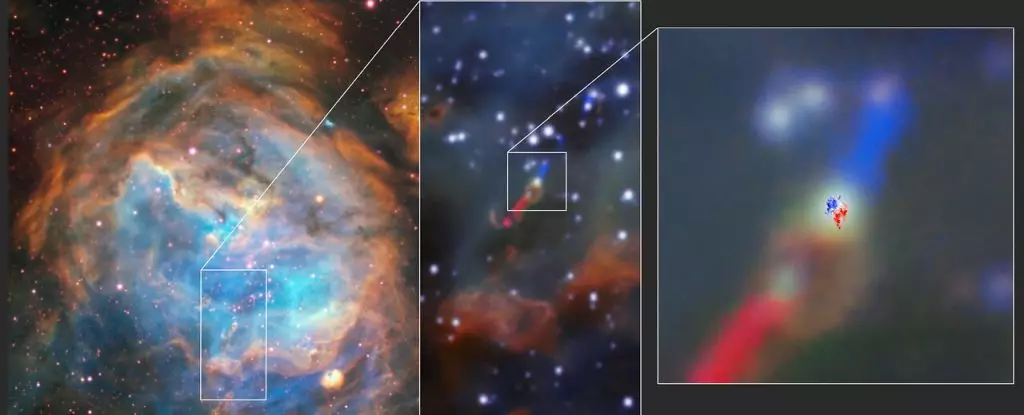A fascinating breakthrough in astronomy has occurred as astronomers have recently detected the first-ever extended disk of dust and gas surrounding a star in a different galaxy. This remarkable discovery in the Large Magellanic Cloud, located 179,000 light-years away from the Milky Way, provides crucial evidence that star formation processes may be more universal than previously thought. This article will delve into the significance of this finding and its implications for our understanding of star and planetary system development.
For the first time, astronomers have observed an extragalactic accretion disc outside of our home galaxy. This groundbreaking event, witnessed by Anna McLeod from Durham University in the UK, has profound implications for the field of astrophysics. The direct evidence of a rotating structure within the Large Magellanic Cloud opens up new avenues of exploration and allows scientists to comprehend the formation of stars and planets in uncharted territories.
Stars are born from dense clumps present within molecular gas and interstellar dust clouds. When these clumps reach a critical density, gravitational collapse occurs. As the clump contracts, it begins to accumulate material from the surrounding cloud, forming a disk structure that revolves around the emerging star. This process resembles water flowing down a drain—a controlled and steady stream. The remnants of this disk ultimately contribute to the creation of planets, asteroids, comets, and dust within a planetary system.
The Atacama Large Millimeter/submillimeter Array (ALMA) radio telescope has been instrumental in the study of stellar disks throughout our Milky Way galaxy. Observations with ALMA have revealed various stages of disk development, some of which display noticeable gaps resulting from the presence of consolidating planets. Despite the plethora of disks discovered within our galaxy, visualizing extragalactic disks poses significant challenges due to their vast distances. However, recent advancements in technology have paved the way for this astounding extragalactic observation.
An Extraterrestrial Quest
The quest to identify an extragalactic stellar disk commenced when scientists using the Multi Unit Spectroscopic Explorer (MUSE) instrument on the Very Large Telescope uncovered indications of a jet in a system named HH 1177. Such jets are characteristic of star formation, as they represent material being expelled from the star along magnetic field lines at the poles. Intrigued by the presence of a jet, researchers aimed to identify the surrounding dusty disk using ALMA and search for signs of rotation.
Unveiling Rotation Patterns
Through their analysis, astronomers found compelling evidence of rotation in the HH 1177 system. The star under scrutiny was determined to be young and massive, actively feeding from the surrounding disk. While this behavior is not unexpected, it differs from protostellar disks observed in the Milky Way in one crucial aspect—the HH 1177 disk is observable in optical wavelengths. Researchers attribute this distinction to the reduced dust content within the Large Magellanic Cloud, creating clearer visibility of the star compared to its Milky Way counterparts. This observation sheds light on the role of the interstellar environment in shaping the characteristics of star formation.
This discovery carries broad implications for our understanding of star formation within different environments and the limitations these environments may impose. Comparing stellar formation processes in the Large Magellanic Cloud to those in the Milky Way enables researchers to comprehend the impact of varying interstellar conditions on the development of stars and planets. Furthermore, this breakthrough highlights the rapid technological advancements in astronomical facilities that have supported such groundbreaking research initiatives.
The detection of the first extragalactic stellar disk represents a significant milestone in the field of astronomy. This monumental discovery not only expands our understanding of star formation processes but also highlights the role of different interstellar environments in shaping these processes. With advancements in technology, the future holds numerous promising opportunities to explore and decipher the mysteries of the cosmos beyond our own galaxy. The ongoing pursuit of knowledge about the universe will undoubtedly lead to further groundbreaking revelations that challenge and deepen our understanding of the cosmos.


Leave a Reply